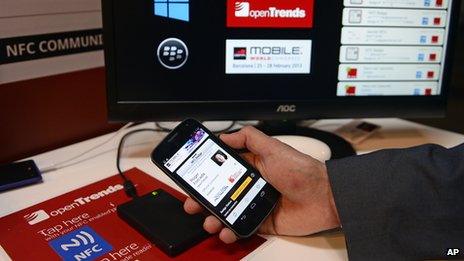NFC - not for consumers?
- Published
- comments
Rory Cellan-Jones takes a look at NFC technology to see how it could turn the smart phone into a "smart wallet"
NFC - three letters that seem to mean an awful lot to the mobile phone industry right now, but nothing to the vast majority of its customers.
At Mobile World Congress this week, there are NFC posters, NFC demos on lots of stands - even a separate conference called the NFC Experience.
The GSMA, external which runs the annual shindig in Barcelona seems convinced that this is the year NFC really catches on - but then they've said that just about every year for the last decade.
Near Field Communications is a technology which allows small amounts of data to be exchanged when you tap two NFC devices together, or touch one against an NFC tag.
Apart from Apple, just about every manufacturer of smartphones now includes the technology as standard, so it is in more than 100 million devices.
I was given a demo of some of the uses on stands where various manufacturers were putting it through its paces.
In one scenario, I checked in at an airport, got access to the business lounge and then got through security, all by tapping my phone at various stages. No need for a paper boarding pass, explained the man showing me round.
Then I took my phone to a poster in the duty free shop, tapped on a picture of a bottle of perfume, and was able to pay to have a gift sent home. Finally, I played a song on my phone, then tapped it on a speaker which played the music.

Testing NFC technology at the World Mobile Congress
Most of this worked quite efficiently (although it took me an age to get the knack of making the music beam to the speaker).
But I remain sceptical. For every use I was shown there are rival technologies which do the same thing, often more smoothly.
Heading through Barcelona airport on the way home, I flashed the virtual boarding pass on my non-NFC phone and went through without showing any physical document - except a passport.
Other technologies such as QR codes, augmented reality and smartphone apps are already competing to make virtual shopping and mobile payments a reality. And streaming music via speakers over wifi or via bluetooth seems a much smoother experience than I found with NFC.
There are some areas where I can see its appeal - tapping phones together to share photos is fun and less fiddly than sending via bluetooth. And maybe I can see a future where you swipe in and out on trains and buses using an NFC phone instead of a card.
Mind you, that idea has been around for quite a while. In 2007 I was involved in a trial, external where I used an early NFC phone to get access to London's transport system and pay for a coffee or a sandwich.
The experiment was hailed a success by the companies involved, but although you can now use NFC credit cards on London buses, there is no sign yet of travellers being allowed to swipe in via their phones.
Still, the GSMA now believes there is enough momentum and enough real-world examples of the technology that millions of us will soon be using it - even if we don't know it.
So convinced were the organisers of Mobile World Congress that they encouraged visitors to get an NFC pass for speedier entry to an event where security involves showing photo ID.
Sadly, the people I met told me that it proved to be a slower way of getting in than the old fashioned non-NFC pass.
Maybe we will all get used to tapping our phones to make life easier, but it is going to take a while.